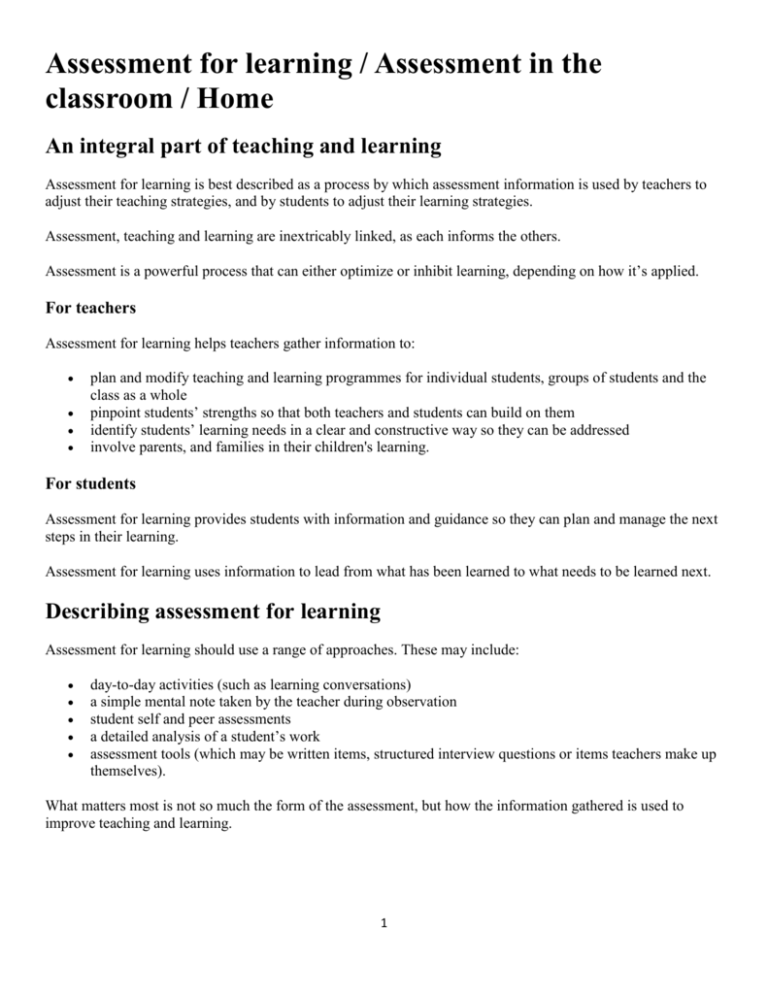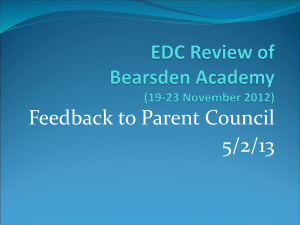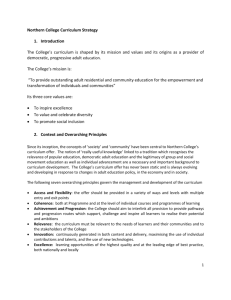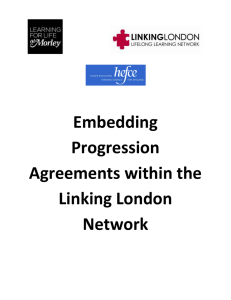Assessment for learning
advertisement

Assessment for learning / Assessment in the classroom / Home An integral part of teaching and learning Assessment for learning is best described as a process by which assessment information is used by teachers to adjust their teaching strategies, and by students to adjust their learning strategies. Assessment, teaching and learning are inextricably linked, as each informs the others. Assessment is a powerful process that can either optimize or inhibit learning, depending on how it’s applied. For teachers Assessment for learning helps teachers gather information to: plan and modify teaching and learning programmes for individual students, groups of students and the class as a whole pinpoint students’ strengths so that both teachers and students can build on them identify students’ learning needs in a clear and constructive way so they can be addressed involve parents, and families in their children's learning. For students Assessment for learning provides students with information and guidance so they can plan and manage the next steps in their learning. Assessment for learning uses information to lead from what has been learned to what needs to be learned next. Describing assessment for learning Assessment for learning should use a range of approaches. These may include: day-to-day activities (such as learning conversations) a simple mental note taken by the teacher during observation student self and peer assessments a detailed analysis of a student’s work assessment tools (which may be written items, structured interview questions or items teachers make up themselves). What matters most is not so much the form of the assessment, but how the information gathered is used to improve teaching and learning. 1 Purposes of assessment / Assessment for learning / Assessment in the classroom / Home Teaching and learning The primary purpose of assessment is to improve students’ learning and teachers’ teaching as both respond to the information it provides. Assessment for learning is an ongoing process that arises out of the interaction between teaching and learning. What makes assessment for learning effective is how well the information is used. System improvement Assessment can do more than simply diagnose and identify students’ learning needs; it can be used to assist improvements across the education system in a cycle of continuous improvement: Students and teachers can use the information gained from assessment to determine their next teaching and learning steps. Parents, and families can be kept informed of next plans for teaching and learning and the progress being made, so they can play an active role in their children’s learning. School leaders can use the information for school-wide planning, to support their teachers and determine professional development needs. Communities and Boards of Trustees can use assessment information to assist their governance role and their decisions about staffing and resourcing. The Education Review Office can use assessment information to inform their advice for school improvement. The Ministry of Education can use assessment information to undertake policy review and development at a national level, so that government funding and policy intervention is targeted appropriately to support improved student outcomes. 2 Description / Purposes of assessment / Assessment for learning / Assessment in the classroom / Home The diagram shows the different groups of people involved in supporting students' learning and the purposes for which they need assessment information. The diagram has layered circles. At the top is "Student and teacher", and "Information for learning". The next layer down has "Information for future learning", and "Next teacher, employer" on the left. On the right is "Information for partnership", and "Parent, family, whānau". The next layer down has "Information for school review and development", and "Leadership team". The layer below that has "Information for governance", and "board of trustees". The bottom layer has "Information for stewardship", and "Ministry of Education". Principles of assessment / Assessment for learning / Assessment in the classroom / Home Above all, assessment for learning must be underpinned by the utmost confidence that every student can improve. It should be driven by the concept of ako, meaning ‘to teach and to learn’. Assessment for learning should enable reciprocal learning where teachers and students share and value each other’s sense-making processes. Knowledge of the learner is vital to ensure assessment is appropriate and fit for purpose. Learning to learn Good assessment should focus less on “do they have the right or wrong answer?” and more on making students’ thinking visible to both teacher and student. It should help develop understanding of the strategies and patterns students have constructed in order to make sense of the world. The assessment for learning process can unlock the approaches used by students and help them to become more aware of not only what they are learning, but how they are learning it. This empowers students to take control of their own learning, by developing their skills of self-regulation. Students can then discuss their developing understanding with their teachers, peers, parents, families and whānau. Independent learners like this have the ability to seek out and gain new skills, new knowledge and new understanding, according to their own needs and learning goals. Building students’ assessment capability When students actively participate in assessing their learning by interpreting their performance, they are better placed to recognize important moments of personal learning. This helps them to identify their own strengths and needs, and discover how to make ‘Where to next?’ decisions. Students should be educated in ways that build their assessment capabilities, so they can take increasing control of their own learning and, through this process, become more effective and independent learners. 3 Students make progress when they develop the ability to monitor their own work. To do this well, they need to understand: what high quality work looks like (examining examples and models of quality work helps develop this) what criteria define quality work (participation in the development of learning goals and assessment criteria helps develop this) how to compare and evaluate their own work against such criteria (peer and self-assessment help develop this). Assessment-capable students can also provide better information to teachers. Better student feedback gives teachers a clearer picture of students’ learning needs and enables more personalized development of next teaching and learning steps. Engaging and motivating One of the most important purposes of assessment for learning is the role it plays in student motivation. Knowledge and understanding of what is to be achieved is not enough. Students must want to make the effort and be willing to keep on engaging, even when they find the learning difficult. Developing students' assessment capabilities engages and motivates them, and helps them to become more independent learners. Assessment that encourages learning promotes motivation by emphasizing progress and achievement rather than failure. When people succeed or fail, they explain it to themselves in a variety of ways (effort, ability, mood, knowledge, luck, help, clarity of instruction etc). It’s the teacher’s role to shift explanations away from uncontrollable ones, towards controllable ones. Assessment-capable students feel greater ownership of their learning and are more likely to attribute outcomes to factors within their control. This engages and motivates students. Content knowledge Knowledge of both curriculum and pedagogical content is essential for effective assessment for learning. Teachers require deep knowledge of the content to be taught and how students learn it. This means having a clear understanding of the concepts, a sense of the likely understandings and misunderstandings students will bring to the classroom and how to best facilitate new learning. To provide effective learning opportunities, teachers need to understand the curriculum, its goals, and how students can progress towards them. Assessment for learning is dependent on knowledgeable teachers who can interpret their observations and act on those interpretations to enhance learning. The ways in which teaching, learning and assessment are structured by teachers are a direct product of their content knowledge and beliefs about how students think and learn. 4 Planned and communicated Assessment for learning should be built into teachers’ planning as a part of everyday classroom practice. Learning goals, teaching strategies and assessment criteria should be carefully matched. Students should know in advance what they will learn, as well as how and why they are to be assessed. Teachers’ programme planning should be flexible so that they can make changes in response to new information, opportunities or insights.Their planning needs to include strategies to check students understand the goals they are pursuing and the criteria that will be applied in assessing their work. How students will receive feedback, how they will take part in assessing their learning and how they will be helped to make further progress should also be planned. A teacher’s planning should provide opportunities for both student and teacher to obtain information about progress towards learning goals, and use it to direct the learning process. Progressive and cumulative Assessment should be valid, fair and suited to the purpose. It should measure progress, not just achievement. Any assessment can only provide a snapshot of achievement on a particular day. Performance will vary from day to day depending on: the nature of the assessment task the conditions in which the assessment is undertaken the purpose of the assessment the student’s preparation the student’s engagement and motivation. To make a valid and fair measure of progress over time, teachers need to analyse information from a range of sources. It’s important that teachers gather information both formally and informally, using a range of approaches to add to or modify their picture of each student’s learning over time. Supports teaching and learning goals Teachers need to know how a given assessment should enhance learning, and how to check if it has. Assessment should emphasize quality student-teacher learning interactions and be fit for purpose. Assessment for learning supports teaching and learning goals in three key ways: 1. Identifying the learning need Assessment information helps teachers and students identify where a student is in terms of their learning, where they want to be, and what next teaching and learning steps can help them to achieve their goals. 5 This means striking a delicate balance. If the next instructional steps are too hard for the student, frustration will be the most likely result. If they are too easy, boredom and disengagement are potential outcomes. Good assessment practice should identify what next teaching and learning steps are achievable, and enable the teacher and student to move from the student’s current state of learning towards their learning goals. 2. Feedback Feedback based on assessment is one of the most powerful ingredients in teaching and learning, and maximizing the quality, appropriateness and use of feedback should be a core aim of all assessment practice. There should be as much or as little feedback as is needed, using a number of approaches if necessary. Knowledge of the learner is essential for knowing what is appropriate and ensuring feedback is delivered in a way that empowers the learner. Feedback can drive a loop of continuous change and improvement for both the teacher and student, as both learn from each other. Feedback in the assessment for learning process: guides the student through the next teaching and learning steps helps teachers assess and modify their teaching in response to student needs. Effective feedback provides clear, descriptive, criterion-based information that enables the student to determine where they are in a learning progression, how their level of understanding differs from their learning goals, and what they need to do to move towards those goals. 3. Next teaching and learning steps To be effective in describing next teaching and learning steps, assessment for learning should be linked to some form of learning progression. A learning progression should clearly articulate what steps make up progress towards an ultimate learning goal. Assessment for learning helps teacher and student locate the student’s position along the learning progression. Progression doesn’t necessarily always happen in a linear fashion. Students will often move far ahead in one area while retaining significant learning needs in another. Part of the art of teaching is supporting students to build on strengths in order to meet needs, and providing students challenging yet achievable steps towards their learning goals. Recognises social and cultural aspects of assessment All aspects of assessment carry a social and cultural dimension. Teachers need knowledge of their students’ cultures, backgrounds and experiences to ensure assessment is appropriate and effective. 6 Social aspects To be effective, assessment for learning needs to take place within a positive learning environment. Students should be encouraged to take risks and make errors, and understand that wrong answers can assist learning just as effectively as right answers. Encouraging a culture of listening critically to one another, responding positively and constructively, and appreciating the different strengths, experiences and skill sets among peers will help create such an environment. If this can be accomplished, students can learn to conduct effective peer assessments of each other. Effective assessment for learning is underpinned by the concept of ako. It recognizes the knowledge, skills and understanding that both teachers and students bring to learning interactions, and it acknowledges the way that new knowledge and understandings can grow out of shared learning experiences. Cultural aspects In the classroom, non-judgmental exploration of teachers’ and students’ own cultural values, assumptions and understandings about learning and assessment may help them to use the differences that surface to develop their own strengths, and identify areas for improvement. Effective assessment practice needs to recognize different values, assumptions and understandings and the impact they have on how students may respond to different assessment approaches. Effective assessment practice should plan for collaborative and collective assessment, in both formal and informal contexts, in order to reflect the educational values of different cultures, backgrounds and experiences. Teaching inquiry Assessment for learning practice needs to undergo continual review and professional discussion based on the impact the practice has had on student outcomes. Teachers need professional knowledge to plan for assessment, observe learning, analyse and interpret evidence of learning, give feedback to students and support students in their self-assessment. Teachers can be supported in developing these skills through initial and continuing professional learning. A culture of professional inquiry where teachers themselves seek out and learn the best ways to improve their skill in using assessment for learning is vital. Professional discussion amongst colleagues is an effective way to do this. In this kind of forum, teachers can share the parts of their practice they have found easiest to change, what was the most challenging to change, what difference it has made for them, and what kind of support best helps them to achieve their own goals for classroom practice. 7







